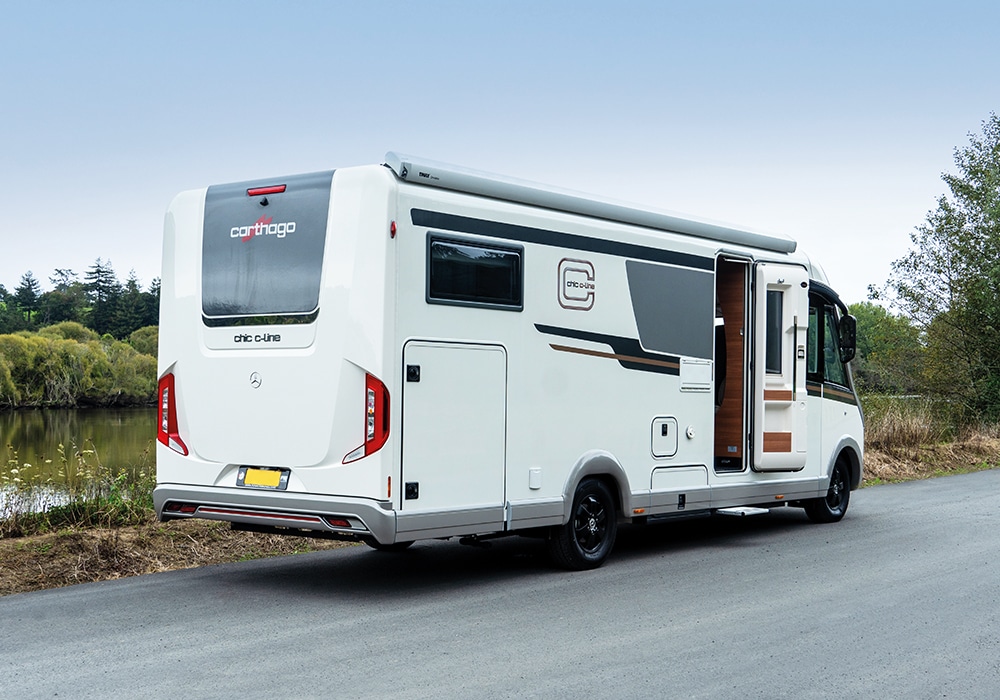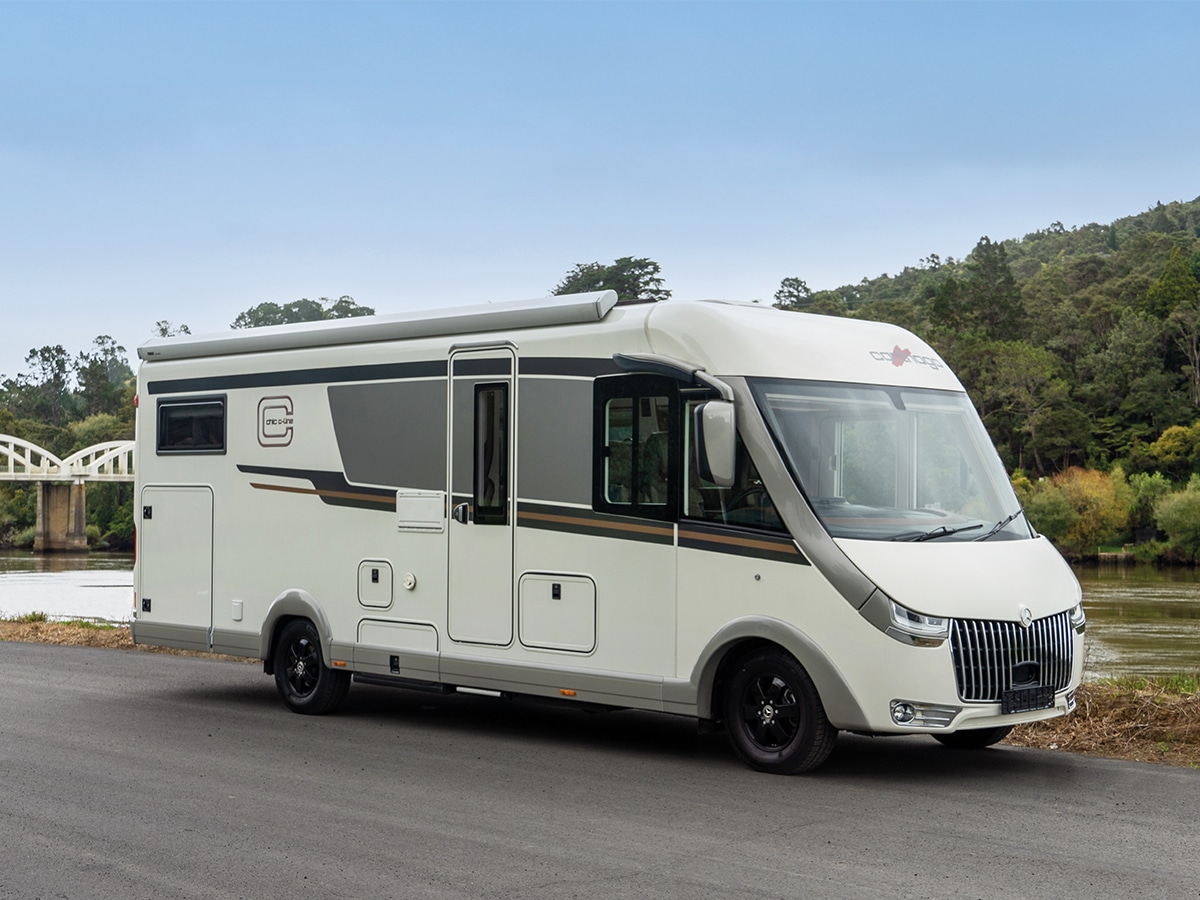A Carthago is easily spotted in the wild; its sleek design, classy interior, and upscale gadgetry sets it apart from other beasts, says Paul Owen.
If you had entered this fully-integrated Carthago C-Line I 4.9 LE L blindfolded and were asked to identify the manufacturer once your eyesight was restored, it would only take a few seconds to come up with the correct answer. All the curves would instantly give the game away. Where other manufacturers appear to favour the use of set squares and rulers when designing their cabinetry, Carthago probably has some computer-aided design software that invents all the beautifully rounded shapes.
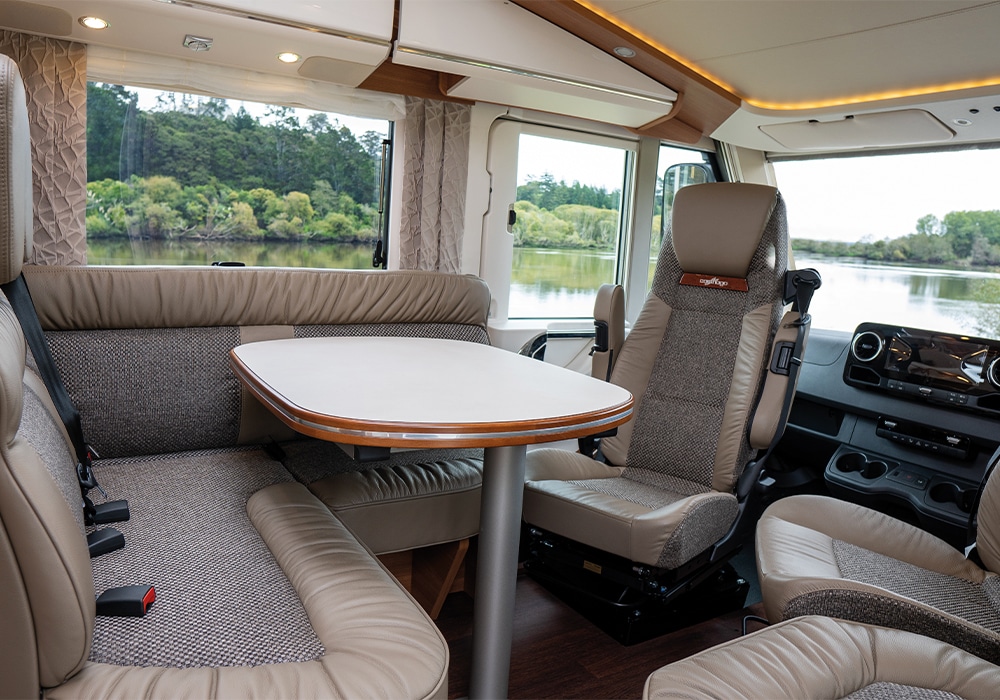
These rounded surfaces are calming to the eye, the table mimicking the shape of a NASCAR asymmetric oval racetrack; the curvaceous bases of the lounge seats looking like waves gently lapping a lake shore. Just about every cupboard and drawer has some curviness built into it. Any interior designer stepping inside this motorhome will probably immediately think that its country of origin is somewhere in Scandinavia. Instead, Carthagos are built in a large mostly glass-enclosed factory near the village of Aulendorf in Swabia, Southern Germany.
There are other giveaways that this C-Line is a Carthago. There’s the trademark capsule coffee machine neatly integrated into the kitchen along with a proper wine rack-equipped cupboard and large slide-out pantry, and this appeal to buyers with a love of all things epicurean is furnished with Chestnut wood veneers that have a rich glow reminiscent of kauri, contrasted with the ivory-like cupboard fasciae. At $345,000, the C-Line I 4.9 LE L is one of the more affordable A-class models from the brand, but it still presents itself as a convincing luxury vehicle.
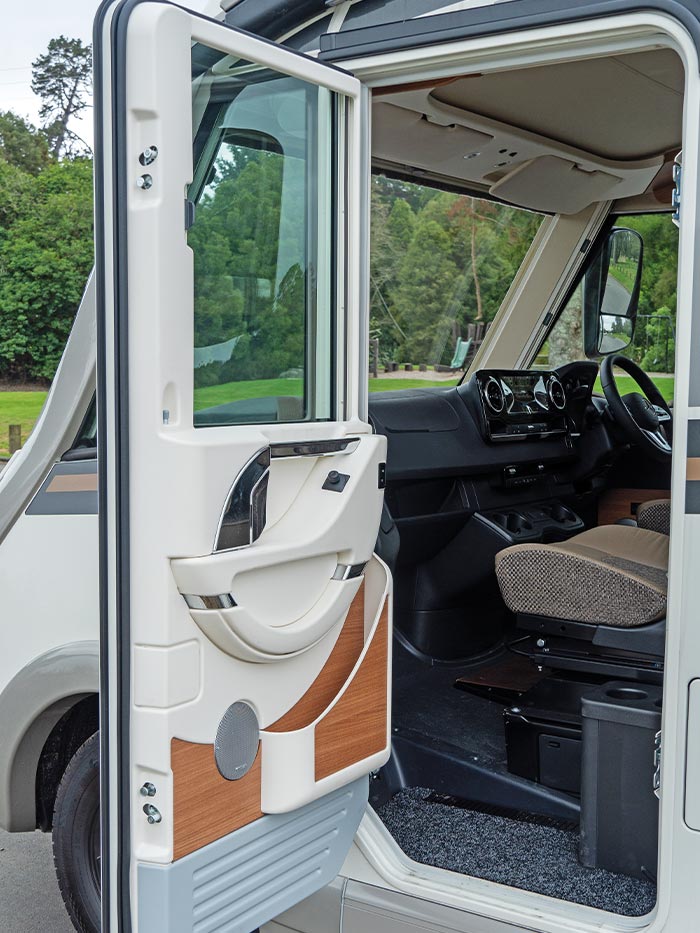
The Mercedes connection
Aulendorf isn’t all that far away from Stuttgart, home to the headquarters of Daimler-Benz. It’s therefore quite appropriate that this C-Line is based upon a Mercedes-Benz 417 CDI Sprinter van. Not that there’s a lot left of that van once it eventually gets fully incorporated into the A-class Carthago.
The Mercedes went on a little tour of Germany before it became the mechanical foundation for a motorhome. It left the Sprinter factory in Düsseldorf, on the banks of the Rhine in Westphalia as a fully-operational chassis lacking all bodywork. It then reached the Bavarian factory of AL-KO SE, where the chassis was dissected and everything behind the front seats was replaced by a lower, lighter frame made of galvanised aluminium, complete with new rear suspension. AL-KO also replaced the front suspension of the Sprinter, spacing the front wheels further apart to create more cabin width and be more compatible with the wider wheel track of the new suspension at the rear. From there, the newly hybridised chassis took a relatively short hop to Aulendorf, where the more detailed and complex creation of a new A-class motorhome began.
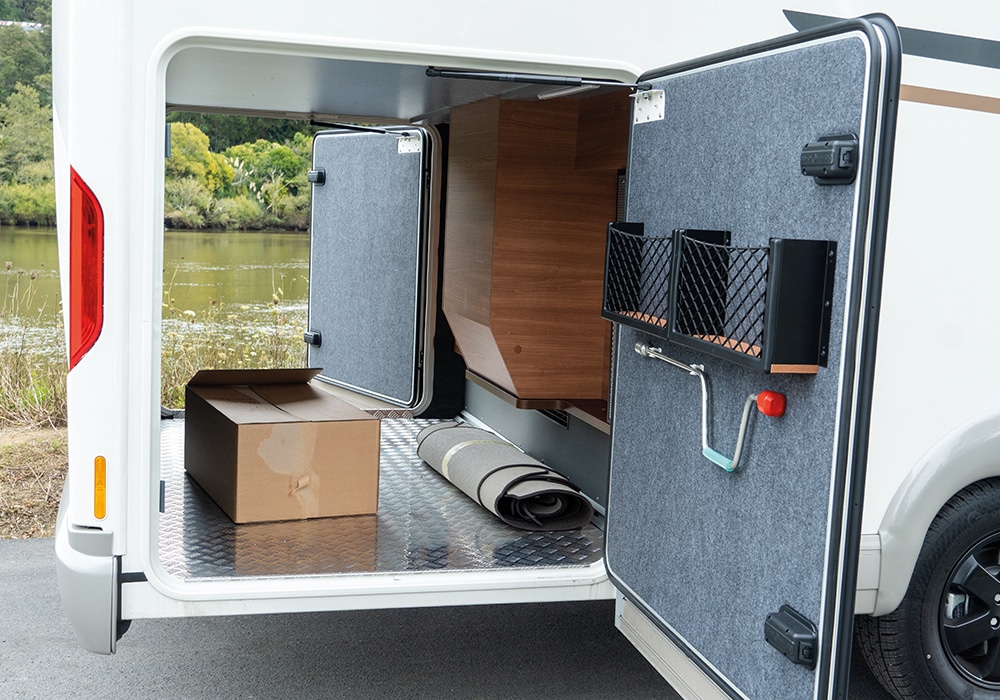
This included the fitting of new heating and ventilation plumbing, the windscreen, wipers and light clusters of a new freshly moulded cab, and the creation of a double floored foundation for the motorhome. As some of Carthago’s 1500-strong team of technicians wired and plumbed the still body-less platform for the electrical and gas systems, others were building the rest of the mostly GRP (Glass Reinforced Polystyrene) motorhome body alongside. It then all came together in one huge effort, the body craned onto the double-floor platform with careful precision so that the already installed wiring and plumbing wouldn’t be compromised.
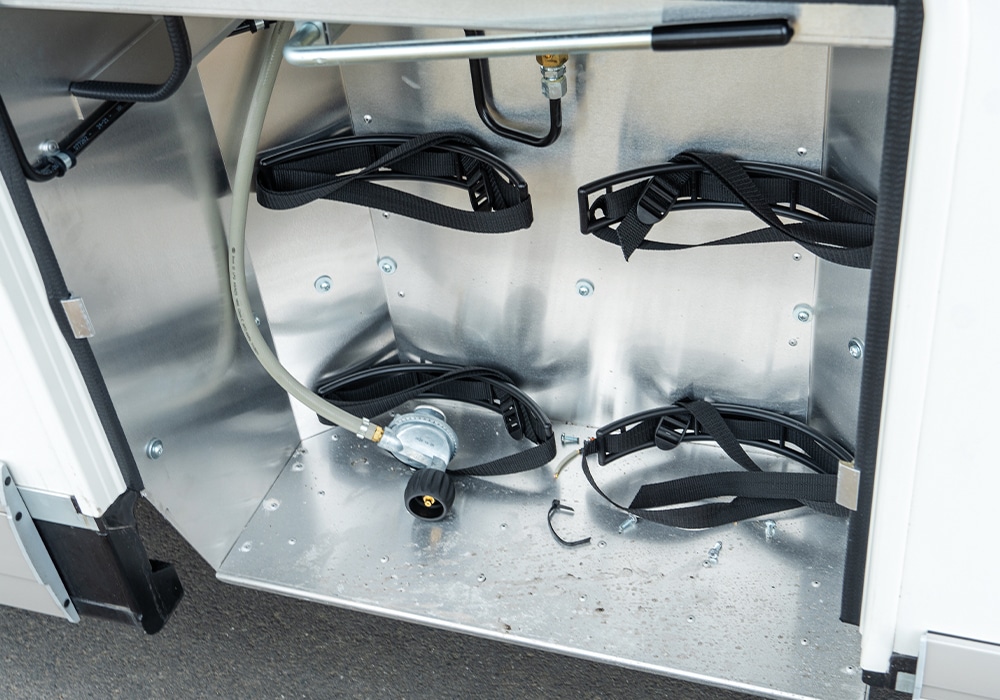
It’s such a dramatic process that Carthago charges visitors five Euros to come and witness it as part of a guided factory tour (the fee is donated to charity). There’s also free camping and power hookup for visiting motorhomers at the factory. You can also hire a Carthago there and go touring the scenic Danube River catchment nearby. Sounds like an excellent plan.
Solid Swabian
With a double-shell GRP roof complete with gutters to deflect rain runoff, side and rear walls lined with aluminium sheet on both the exterior and interior sides, GRP floor covering, and a thick layer of high-performance RTM hard foam insulation all round, the Carthago’s body is solid, easy to heat and cool, and weather-tight. The construction is backed up by a 10-year warranty against water ingress, and aluminium frame members secure the side walls to the floor with the Permatex cold bonding adhesive applied along the entire length of the body. There’ll be no shifting it as Permatex bonds aluminium to another material with a join that is stronger than any weld.
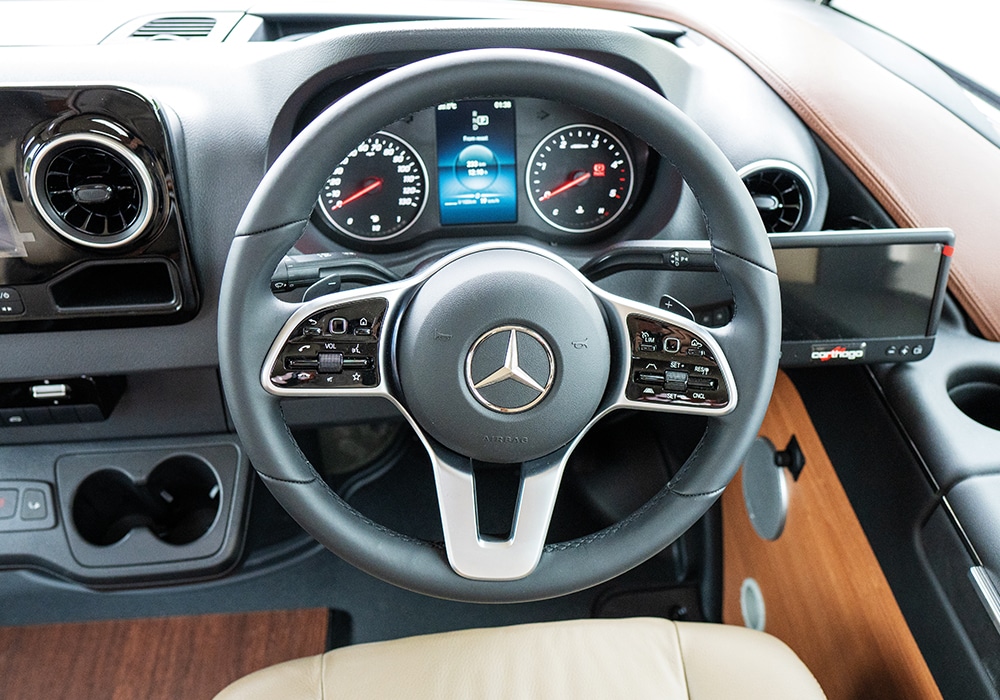
In the Mercedes Sprinter-based version of the C-Line I 4.9 LE L, the construction results in a body that is 7.8m long, 2.8m wide, and 2.9m high, sitting on a wheelbase that measures 4.4m long. When it leaves the factory the Carthago weighs 3,330kg, rising to 3,515kg when in roadworthy condition. The maximum GVM (Gross Vehicle Mass) is 4500kg, allowing a payload of 985kg. Maximum towing capacity is 2000kg for braked trailers.
Powering it all is Mercedes-Benz’s 2.2L four-cylinder turbo-diesel engine, fully Euro 6 emission standard compliant with its 22L AdBlue reservoir and driving the front wheels via a nine-speed automatic transmission. The 2.2 develops a healthy 170bhp (125kW) of power and 400Nm of force, and it feels responsive and willing when driving the C-Line. Official fuel use figures when the powertrain was motivating a Sprinter van were recorded at 7.8-8.5litres/100km, consumption performance that should be directly comparable to that of the Carthago.
The most visible remnants of the van that donated the C-Line’s platform are the original Mercedes-Benz wheel trims, the remote key, the dashboard and the driving cockpit. Naturally, there’s a large three-pointed star in the centre of the multifunction steering wheel, which includes controls for the radar-enhanced intelligent cruise control, and there’s a wide screen in the middle of the dash to access Merc’s MBUX infotainment system complete with satellite navigation. Driving aids include side wind assistance, hillholder, traction and stability control, and automatic headlight control. A separate screen, added by Carthago to the right of the steering wheel, displays the view from the high-mounted reversing camera.

Are we sitting comfortably?
Carthago hot-rodded the Mercedes Sprinter seats in the C-Line, retaining the original adjustable supports and mounts but adding their own upholstery on top. The ‘Aguti Roadliner’ seats are covered with the same materials as the rest of the lounge – in this case beige leatherette with chequered black/ white mesh inserts, a nice contrast to the chestnut wood and gloss ivory cabinetry. The backs of the Roadliners are quite a bit higher and more supportive than the stock Sprinter pews. This is a boon any time that the pull-down double bed above them doesn’t have to be deployed but they cause a bit of faff when it does as you have to fold the seat backs forward to allow enough space for the bed to fully lower. Access to this occasional bed is by stepping up on one of the lounge benches as it is low enough to not need a ladder.
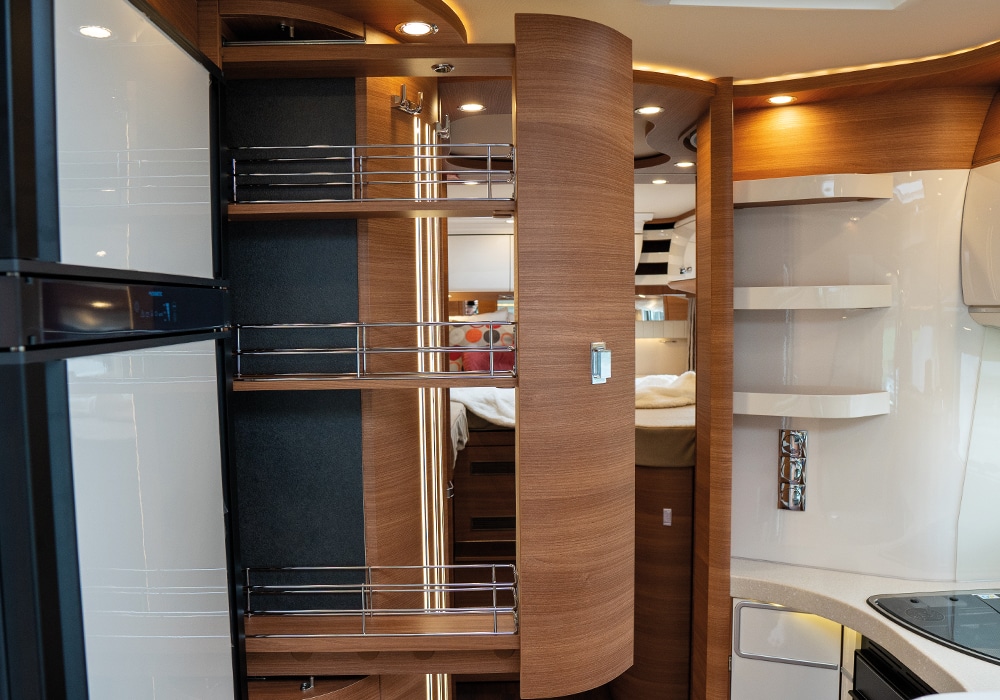
That’s a practice that will likely become a well-oiled routine over any prolonged touring with four people to accommodate at bedtime. Meanwhile, that quartet gets to enjoy one of the nicest motorhome lounges in RV-dom. The seats have multiple layers of foam of differing densities creating an ideal blend of comfort and support. The table rotates 360 degrees and can be adjusted over two planes to suit the seating pecking order of the day. When the conversation or the card games end, a flat TV screen of up to 40” can be slid into view from behind the side-facing bench nearest the habitation door. A final finishing touch to the living area is the shoe locker neatly hidden behind the curved corner of the forward-facing bench seat.
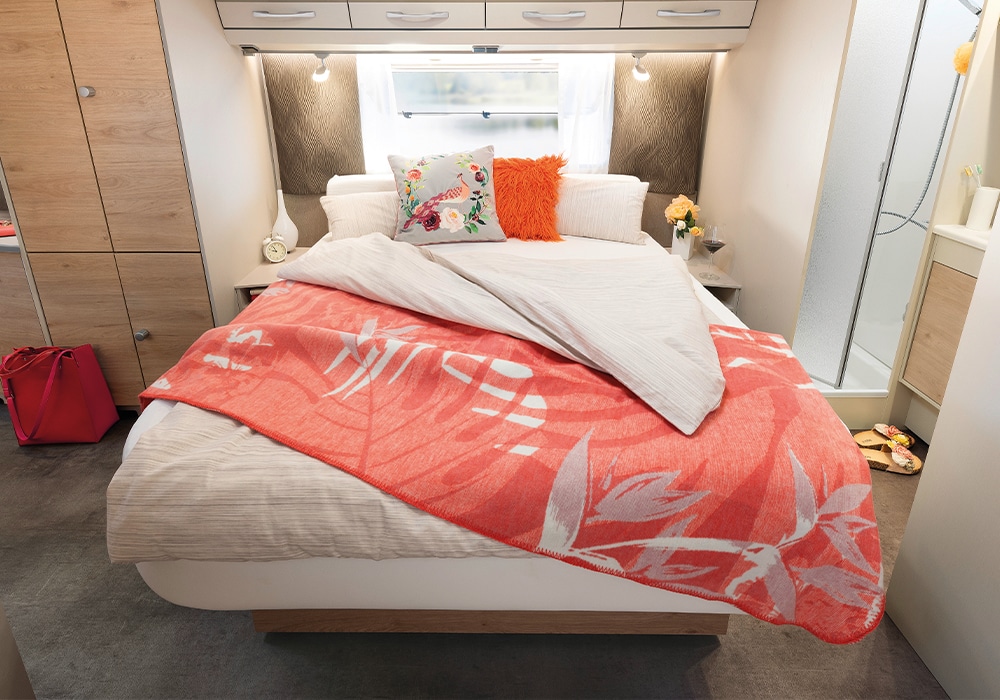
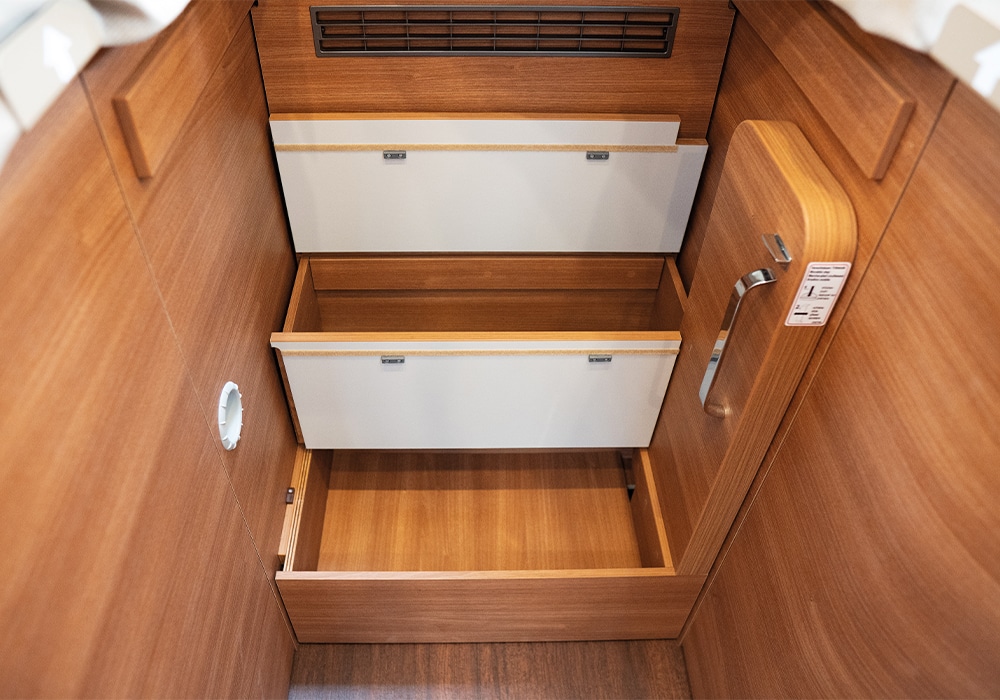
The treasure hunt
Speaking of hidden storage places, the Carthago has them all over the place. Two removable panels in the floor give access to substantial stowage areas located in the 220mm gap between the two floors. One features a basin-like lower floor recess that allows items as high as 70cm to be stored there. The other is also accessed via a locker door outside, and although the height is restricted to 22cm, longer items such as folded outdoor furniture can be stashed there.
Further unexpected stowage can be found inside the individual steps leading to the twin fixed single beds at the rear of the C Line. There’s also a full-length wardrobe between the bedroom stairwell and the washroom, which is similarly hard to spot at first.

Meanwhile, the rear garage might be a more highly visible place to store your stuff, but it’s no less clever. It can cart up to 350kg of stuff, and its size is large enough to squeeze in a motor scooter (BYO ramp). An aluminium frame member provides eight tie-down eyes, and the garage floor is comprised of a double-layer of GRP for extra strength, the top side covered with an anti-slip coating. The area is totally frostproof as it’s well insulated and receives warm air from dedicated heating vents. Your Vespa probably doesn’t enjoy such a cosy life in the garage at home.
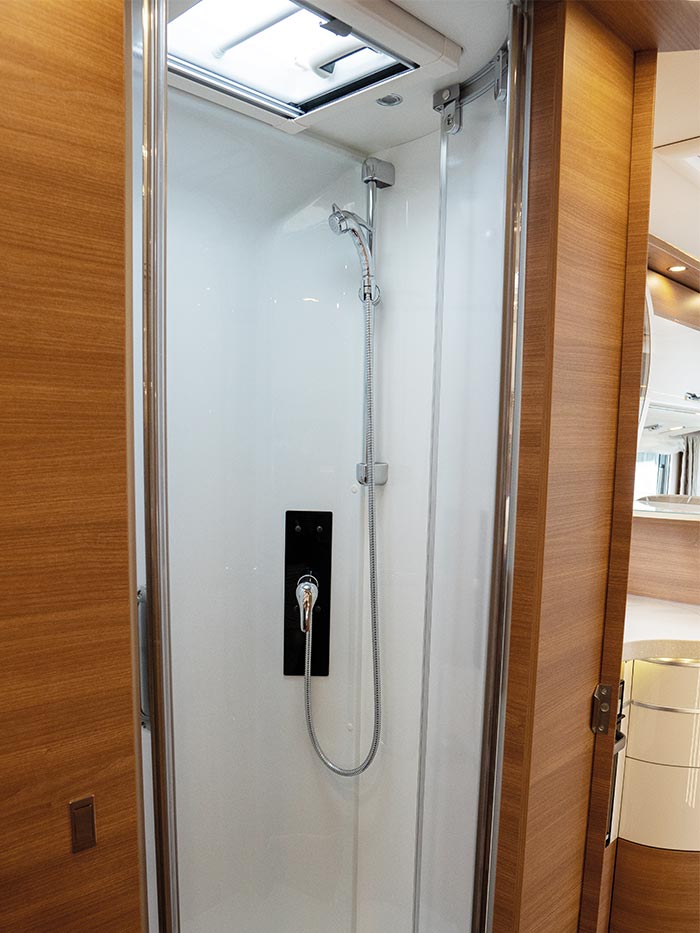
Plugged up
The garage is also where the heart of the Carthago’s electrical system can be found, giving instantaneous access to the 16A automatic domestic battery charger, all fuses, and fuse protection. The twin 80Ah gel batteries are located between in the heated gap between the two floors, keeping their voltage stable in times of cold weather. It’s also where the Truma Combi 6+ gas-powered boiler/heater hangs out, its octopus-like ducts sending warm air to the cab, front lounge, door entrances, garage, as well as warming the entire inter-floor cavity. The C-line’s 170L freshwater and 140L greywater tanks are also mounted there, negating any need for frost protection. There’s a network of five 230V plugs inside the C-Line, located above the bed, and in the front lounge, washroom, kitchen and garage. USB sockets are also strategically placed in similar locations.
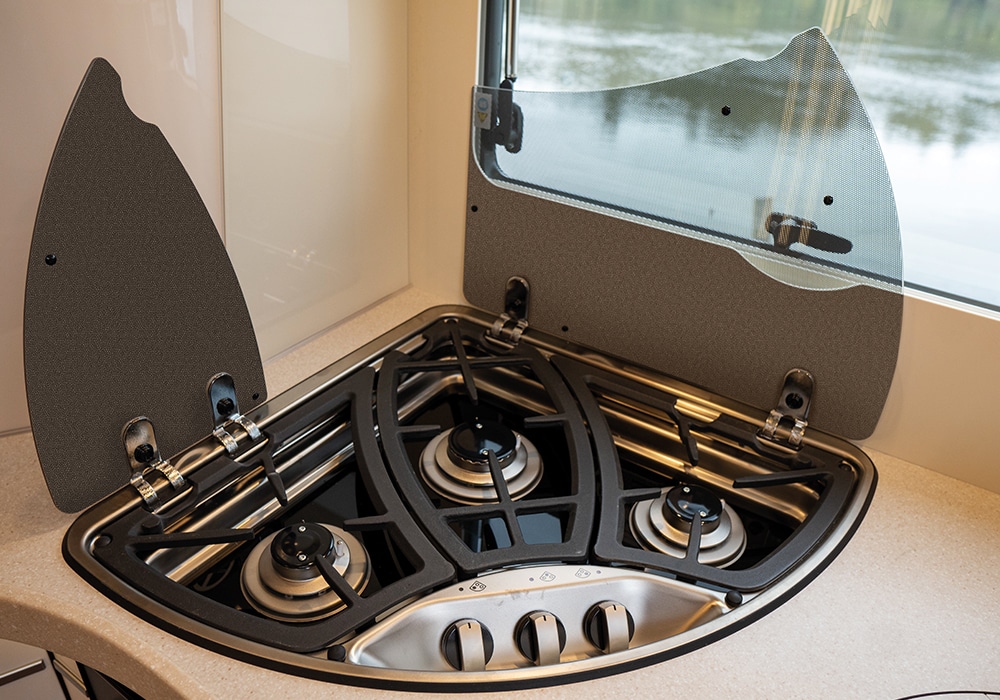
A kitchen for gourmets
It might appear a little compact in terms of longitudinal real estate, but the kitchen of the C-Line is a highly-workable, well-conceived space. You prepare and cook with your back to the spacious 12v/230v/ gas fridge, facing a bench with a three-burner hob and a multi-tasking sink/tap. Below the bench is a proper oven/grille, flanked on one side by a cupboard with shelves holed to secure wine bottles, and on the other by a triple-stack of seriously curved deep drawers complete with soft-closing and anti-slam runners. Below the oven is a drawer that incorporates two disposal bins, one for landfill and the other for recycling. But the pièce de rèsistance is that sink. It has a split cover, and the larger section can be slotted into a sidewall to create extra bench space, Meanwhile, the tap can be extended by pulling out the end piece on a hose – handy if someone calls at the kitchen window with an urgent need to have something rinsed off.
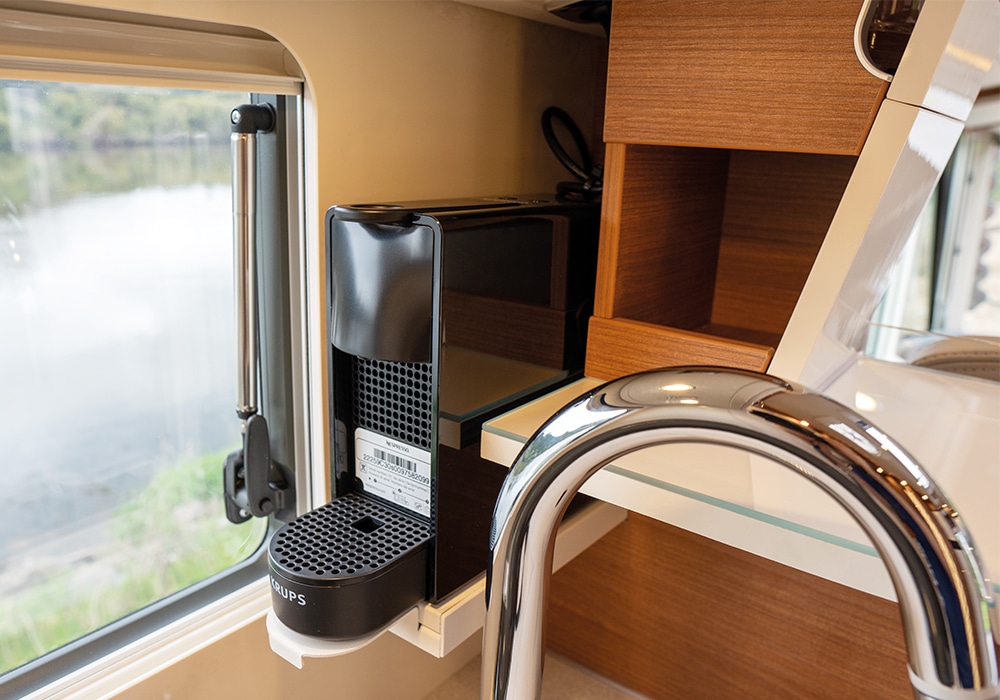
Rest assured that the washroom/toilet/ separate shower area is no less impressive than the rest of the C-Line I 4.9 LE L. The Carthago might cost $97K more than the recently reviewed Pilote G740FC, but for a fortunate few that premium will be well worth paying.
For more information, visit zionmotorhomes.co.nz
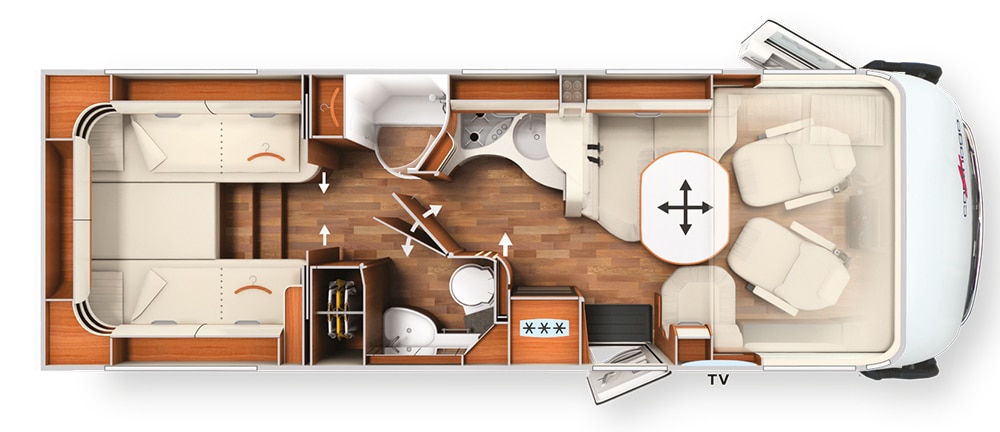
| SPECIFICATIONS | |
|---|---|
| MAKE & MODEL: | Carthago C-Line I 4.9 LE L |
| CHASSIS: | Mercedes Sprinter chassis, front wheel drive |
| ENGINE: | 2.0 litre turbo-diesel, 170bhp |
| BERTHS: | 4 |
| LENGTH/WIDTH/HEIGHT: | 7900mm/2270mm/2945mm |
| FRESH/GREY WATER: | Fresh 170L /Grey 140L |
| UNLADED MASS (TARE): | 3515kg |
| GVW/PAYLOAD: | 4500kg/985kg |
| PRICE: | $345,000 |
